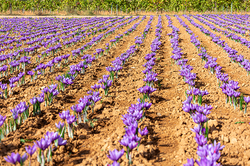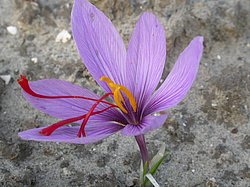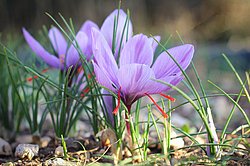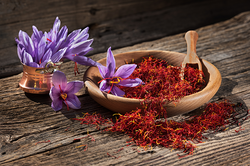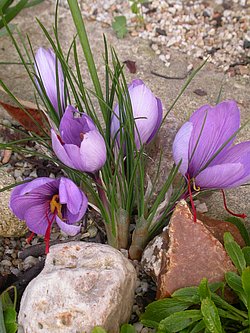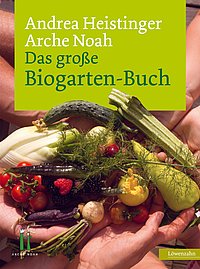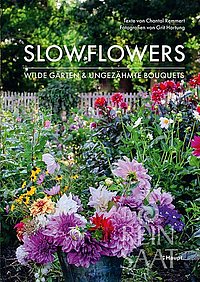E-Mail office(at)reinsaat.at
We are available by phone and our farm shop is open:
Monday – Thursday, 8:00 AM – 5:00 PM & Friday, 8:00 AM – 4:00 PM
(Lunch break 1:00–1:30 pm)
ReinSaat-Blog | Johanna Yagi
We are pleased to regularly present blog posts here from our ReinSaat colleague Johanna Yagi. She is one of our ReinSaat experts in vegetable cultivation and breeding and will share her extensive knowledge and experience on the topic of open-pollinated vegetable, herb, and flower diversity. We hope you enjoy reading!

Crocus sativus SAFFRON – refinement for garden and kitchen
Saffron (Crocus sativus), from the iris family, originally comes from the Aegean region. Resulting from a spontaneous mutation of the Crocus species Crocus cartwrightianus, saffron crocus develops larger flowers with significantly longer stigmas. These contain the unique, complex aromatic profile, blending spicy-earthy, floral-warm, and subtly bitter notes, along with the typical intense, deep-red colouring power.
For centuries, saffron has been cultivated in the warm Mediterranean regions and the Middle East. However, cultivation is increasingly popular also in German-speaking regions – both in professional agriculture and in home and hobby gardens. Cultivation under Central European climate conditions poses specific requirements regarding soil, climate, and care.
Read here the most important aspects for successful saffron cultivation:
The right location is key …
As a Mediterranean plant, Crocus sativus is sensitive to cold and prefers warm, sunny locations sheltered from the wind. A minimum of 6 hours of sunlight per day and temperatures around 15°C, even in September, support flower formation and aroma development.
Saffron is suitable both for planting in garden beds and in pots. In either case, the soil should be loose, low in humus but nutrient-rich. To prevent rotting, waterlogging must be strictly avoided. Before planting, deep soil preparation incorporating organic fertilizer or compost is recommended.
Planting and care…
Saffron bulbs are planted directly into the bed or pot from July until the end of August. Keep in mind that saffron propagates vegetatively – not by seed, but solely through bulbs. In late autumn, daughter bulbs will form and need sufficient space.
Garden bed:
Bulbs should be planted about 10–15 cm apart and 10–15 cm deep. A mulch layer after planting is helpful to suppress weeds.
Pots:
Use a pot of at least 10 litres per bulb. To avoid waterlogging, we recommend a drainage layer made of expanded clay or gravel.
After planting, saffron does not need watering – root development and sprouting are supplied by the bulb itself. During the growing and flowering phase, occasional watering during dry or drought periods is sufficient. During dormancy (May to August), no watering is required.
Whether in beds or pots, saffron will appreciate a light application of slow-release organic fertilizer or compost in spring.
Saffron propagation
In late autumn, after saffron flowering, the mother bulb produces small daughter bulbs, which can be transplanted individually in April or May.
Interesting fact:
Due to its origin as a genetic mutation, saffron has a triploid chromosome set. This means it does not produce fertile seeds and can only propagate through daughter bulbs, which are genetic clones of the mother plant.
From bed to kitchen – Harvest and post-processing
To ensure the highest quality of the world's most expensive spice, harvesting takes place in the early morning hours. As soon as the flowers are fully opened, the saffron threads (stigmas) are carefully plucked or cut from the blossoms by hand.
The subsequent drying process is crucial for the colour and flavour of the spice. Air-drying is recommended, where the threads are laid out and dried slowly in a well-ventilated place. It is important that the temperatures are not too high, to preserve the delicate aromatic compounds of saffron. Another method is shade-drying, in which the drying takes place in a dark area to retain aroma and colour. We do not recommend machine heat-drying or roasting. With both methods, the average drying time is 3–4 days.
Storage and shelf life
To preserve quality, aroma, and colour for as long as possible, store saffron in airtight, light-proof glass or metal containers at temperatures between 15–20°C. Avoid heat sources such as stoves, radiators, or direct sunlight. Would you like to store your saffron harvest for more than 1–2 years? With proper protection from moisture, this is possible in the refrigerator.
Tips and tricks
Frost protection:
In colder regions of Austria, winter protection through mulching or covering with leaves/fleece is advisable.
Pest control:
Slugs and voles can damage the bulbs. We recommend considering appropriate protective measures (vole mesh, slug barriers) before planting.
Yield optimisation:
Proper care, minimising weed pressure during the growth phase, adding compost, and relocating newly formed daughter bulbs during dormancy can promote the development of larger flowers.
Conclusion
With successful cultivation, we are rewarded in October with bright violet flowers of high ornamental value and deep red saffron threads full of vibrant colour and intense aroma.We wish you a successful saffron cultivation!

Request a free printed version, browse online, or download the PDF.
Request a free printed version, browse online or download the PDF.

